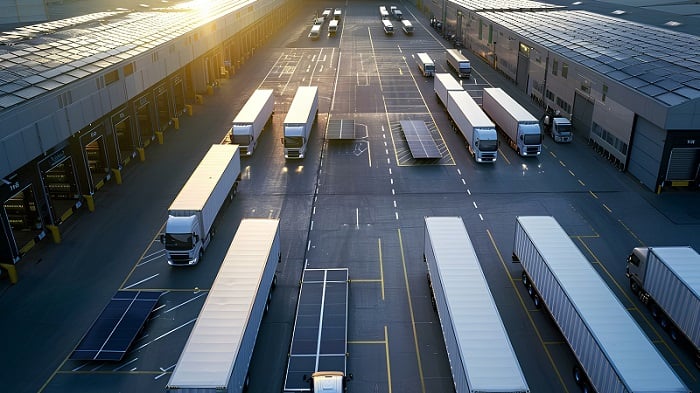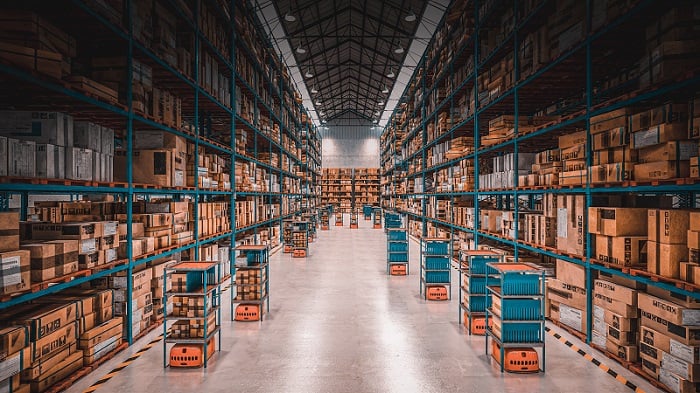Learn about the various strategies and algorithms used to optimize trucking routes and manage the loading and unloading of warehouses, all to keep the supply chain world running smoothly.
In our previous AI article, we talked about how supply chain management has evolved into a complex, interconnected network in recent history. We also explored some of the most common algorithms employed in supply chain optimization, focusing on demand forecasting. We also introduced a high-level overview of how manufacturing and logistics processes are also part of the larger supply chain network.
We are now going to zoom in on specific areas of transportation and yard management and talk about how AI is also having a profound impact on transformation here. We will highlight the most significant algorithms employed in these two key areas. Our goal is also to help create a clear picture of all the sectors in which AI is changing and how all of them are (or can be) interconnected.
AI in Transportation and Logistics
If we visualize the supply chain as a network in a graph, then transportation and logistics are represented by nodes and lines connecting the network elements. Transportation is the movement of goods across the supply chain, from raw materials through distribution to customers.
One of the most important challenges currently facing this sector is the large amounts of data generated each day, which is largely fragmented. This landscape of data leads to inefficiencies and higher costs due to a general lack of overarching visibility. Therefore, adopting AI-enabled solutions has become essential to leveraging existing data and integrating it into cohesive databases. There is immense potential for leveraging AI and Machine Learning in transportation and logistics.

Figure 1. AI is transforming the industry of transportation and logistics.
Many of the same algorithms discussed in our previous article can be employed in transportation and logistics. Predictions from demand forecasting help to optimize transportation routes and schedules. Recurrent Neural Networks (RNNs) and ARIMA (Auto Regressive Integrated Moving Average) are two popular algorithms for demand forecasting and fleet management.
Route optimization is another classical problem in transportation management. Finding the most optimal routes for goods deliveries minimizes costs, improves timeliness, ensures efficient resource utilization, and increases operational efficiency overall. Ant Colony Optimization (ACO) is one type of algorithm that enhances route optimization.
ACO was developed in the early 1990s and is inspired by how ants can find the shortest paths to the nearest food source. Ants rely on traces of pheromones left behind by other ants who traveled the same path previously. The strength of the pheromone traces along a certain path provides an indication of the number of ants that have traversed it before. Therefore, a stronger scent increases the likelihood of finding a food source. Further iterations converge into an optimal route. ACO operates on the same principles to determine the best transportation routes. In fact, the abstract concepts of pheromone strength and decay are applied in mathematical formulas.
Automated freight matching is another significant application of AI in transportation management. It relies on Support Vector Machines (SVM) to find the best possible match for pairing shipments to carriers.
AI in Yard Management
Yard Management is sometimes overlooked as the discipline that it is. People often perceive it as an extension of either the warehouse or the transportation fleet. However, handling trucks and goods within a facility’s yard comes with its own unique set of challenges and complexities.
AI is also stepping into yard management to help drive efficiency. Without the data generated by Yard Management Systems, the link between data from inside the facility and the outside world would be broken.

Figure 2. AI is helping solve many of the pain points existing in yard management today.
The most pressing issue in yard management is the efficient scheduling of truck docks. Proper allocation of docks to inbound and outbound trailers helps drive operational efficiency and positively impacts transportation management.
These tasks are best represented by what is known as Constraint Satisfaction Problems (CSP). AI algorithms dealing with CSPs aim to find a solution meeting a set of constraints applying to a group of variables. Some of the constraints found in yard management include trailer or transportation type, average loading times, dock availability, scheduling conflicts, and scheduling priorities. The variables can be the total number of docks at the facility, the total number of parking spots in the yard, and the yard utilization, among others.
The algorithm evaluates multiple scheduling scenarios, applying the given constraints to recommend the best possible set of dock assignments.
It is also worth mentioning that the principles and algorithms of predictive maintenance also apply in the yard. Traditional fleet vehicles, such as yard jockeys, but also modern automated alternatives like autonomous mobile robots (AMRs), can benefit from predicting failures through data analytics.

Figure 3. Robots at work in a warehouse.
AI in Warehouse Management
We have now arrived and entered the facility’s four walls. The warehouse is a dynamic environment where efficiency and precision are top priorities. The levels of orchestration found in most warehouses, particularly large ones, are fertile ground for transformation through artificial intelligence.
The next article will introduce you to important algorithms employed in warehouse management, as well as some of the most cutting-edge AI-powered robotics available.
Copyright Statement: The content of this website is intended for personal learning purposes only. If it infringes upon your copyright, please contact us for removal. Email: admin@eleok.com
